Reading at home is more than a pastime—it’s a daily ritual that deserves its own corner of comfort and inspiration. Whether it’s a quiet space to unwind or a statement of intellectual charm, a well-thought-out home library elevates the entire living experience. As homes evolve into multifunctional sanctuaries, the demand for personalized reading spaces continues to rise. From compact solutions to grand layouts, the right home library idea blends functionality with ambiance, making it relevant for every lifestyle. This guide presents carefully curated concepts that align with current trends while boosting both aesthetic appeal and practical value in any home setting.
Under-Stair Alcove Library
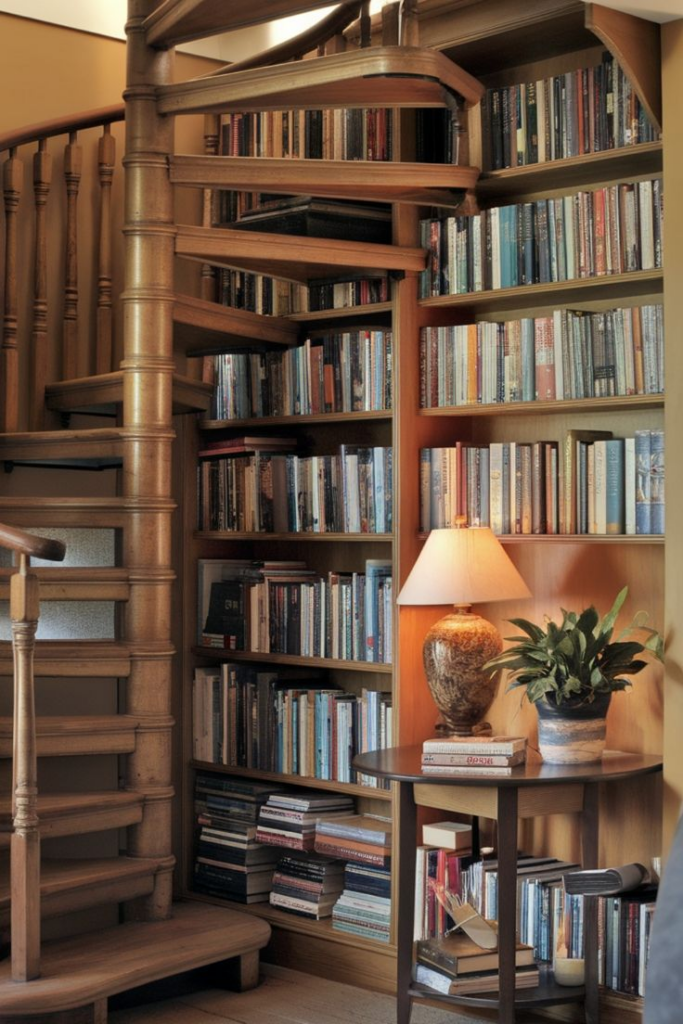
Tucked beneath a staircase, this clever use of underutilized space allows for a compact yet functional home library. Built-in shelving that follows the contour of the stairs creates an eye-catching architectural statement while offering ample storage for books. Custom carpentry ensures the shelves fit seamlessly, maximizing every inch without crowding the area. Pairing the alcove with a cushioned bench or low-profile reading chair turns it into an inviting mini reading zone. Soft downlights or motion-sensor LEDs help illuminate titles without overwhelming the space. A neutral color palette with wood or matte finishes keeps the aesthetic grounded, making it suitable for most interior styles. For homeowners dealing with limited square footage, this layout offers both practicality and visual charm. Consider sliding glass doors or a curtain for added privacy if the stairs are in a high-traffic zone. This small-scale design delivers big results, making reading a central part of everyday life.
Window Seat with Integrated Bookshelves
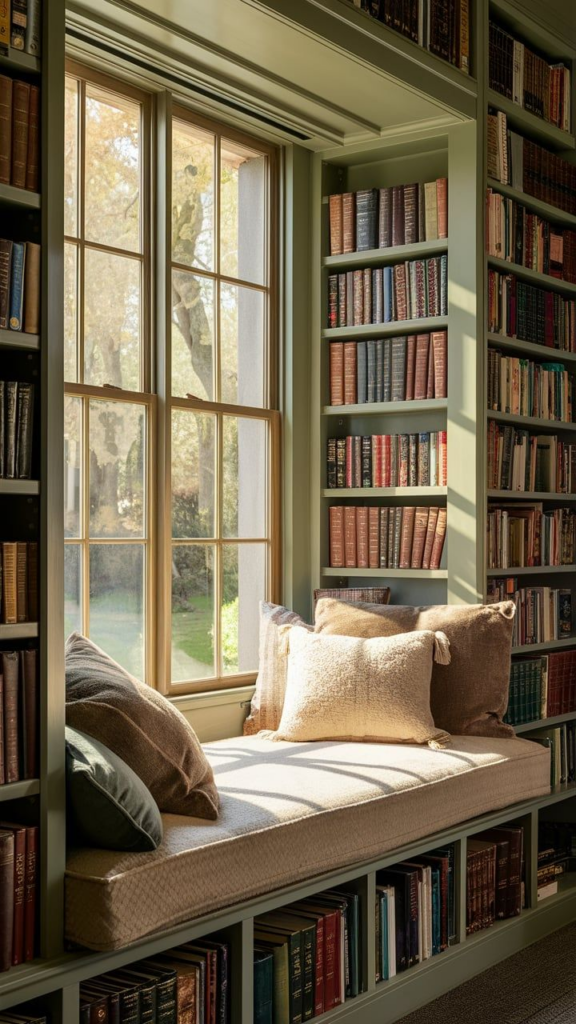
Positioning a reading nook by the window offers natural light, serenity, and an ideal setting for built-in bookshelves. Surrounding the seat with vertical shelving on both sides and overhead creates a well-framed space that blends aesthetics with functionality. Under-seat drawers or cabinets can be added for bonus storage without disrupting the design. Padded cushions with layered throw pillows make the seat more inviting, while wall-mounted sconces ensure adequate illumination after sunset. White or light-toned shelving helps reflect daylight, making the area feel larger and more open. This type of layout suits bay windows particularly well but can be customized for straight-frame windows too. Whether you’re sipping tea or diving into a novel, this nook encourages extended lounging. It’s not just about storage; it’s about shaping an experience. The blend of books, views, and comfort ensures this becomes one of the most cherished spots in the home library.
Floor-to-Ceiling Book Wall

Establishing a full-height bookshelf transforms any blank wall into a dramatic and efficient library space. Running shelving from floor to ceiling maximizes vertical real estate, ideal for homes where horizontal space is limited. Depending on ceiling height, modular sections or custom-built units ensure structural integrity and visual symmetry. Anchoring tall bookcases securely into studs enhances safety, especially in homes with kids. Adjustable shelves cater to changing book sizes, collectibles, or décor pieces. A rolling library ladder introduces both elegance and functionality, allowing easy access to upper tiers. Neutral or stained wood finishes pair well with most interiors, though color-matched backs can be used to accentuate visual depth. Integrated lighting along vertical columns adds subtle brilliance and showcases your collection. By turning a plain wall into a curated literary display, this solution offers both artistic flair and significant storage. It’s a statement piece that commands attention and invites exploration.
Convertible Bookcase Door

Designing a bookcase that doubles as a hidden door adds intrigue and functionality to your library layout. Often seen in luxury interiors or period homes, this clever mechanism serves both as storage and a discreet entrance to a private space. Precision hinges and a reinforced frame ensure smooth operation without compromising structural stability. Magnetic latches or touch-sensitive panels maintain a flush look when closed, keeping the disguise intact. Custom-built models can be tailored to hold standard book sizes while maintaining load-bearing balance. Painted to match wall tones or styled in rich woods, the bookcase-door combo fits modern, rustic, or transitional aesthetics. Beyond visual appeal, this concept allows homeowners to maintain privacy for offices, reading rooms, or personal sanctuaries. Thoughtfully integrating ambient lighting inside and outside the hidden entry further enhances the allure. This isn’t just about storage—it’s about turning a simple bookcase into a conversation-starting feature with timeless charm.
Attic Retreat Library
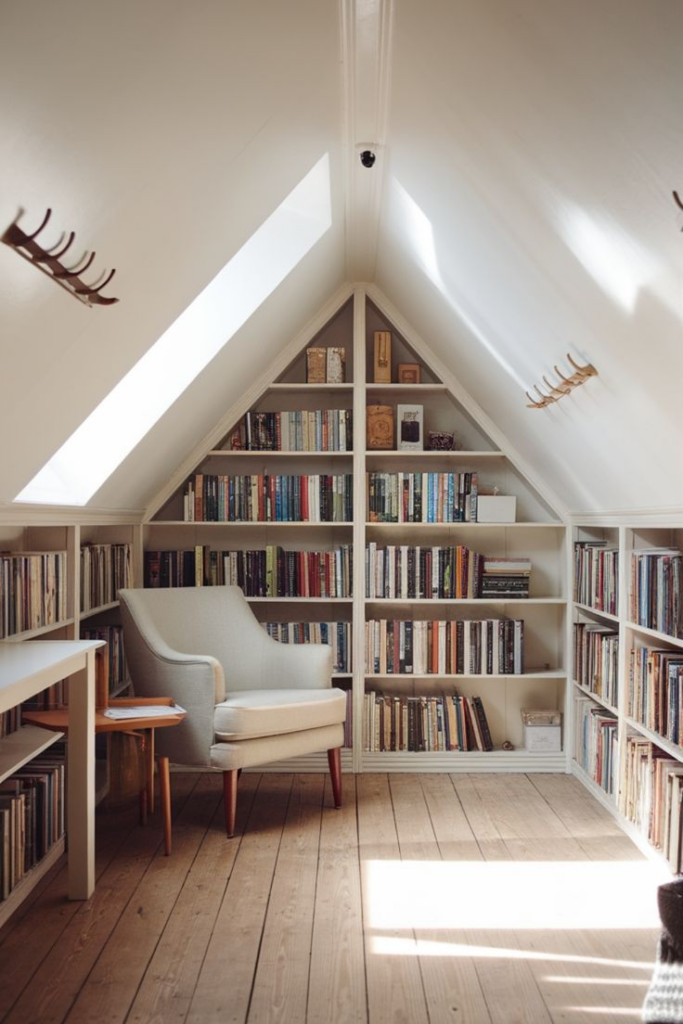
Utilizing attic space for a personal library transforms an often-overlooked area into a peaceful literary haven. Sloped ceilings and dormer windows offer character, while the quiet setting is ideal for focused reading. Low-profile shelves fit perfectly along angled walls, maximizing use without cluttering. Built-in storage under eaves ensures no space goes to waste, while skylights or roof windows bring in natural light to reduce dependence on artificial lighting. Sound insulation is key for serenity, particularly in homes with active households. A plush area rug and oversized floor cushions add warmth to an otherwise stark space. Consider installing a compact electric fireplace for additional comfort and ambiance. Whether lined with fiction, academic texts, or collectibles, the attic library becomes an escape within your own home. This design is perfect for those seeking solitude, allowing hours to pass unnoticed in a quiet corner filled with stories and personal inspiration.
Library Ladder System

Making high shelving accessible without compromising design requires a well-executed library ladder system. Fixed rail ladders or hook-on sliding types provide flexibility based on room layout and user needs. Ladders crafted in oak, walnut, or metal contribute to a cohesive aesthetic while offering durability. Placement along long book walls adds charm and function, making tall collections reachable without strain. Safety stoppers and non-slip rungs ensure usability for all age groups. Brass hardware or matte black finishes help the rail system blend into traditional or contemporary interiors. When not in use, the ladder can be secured vertically or stored off to the side, preserving floor space. This element introduces an old-world library feel while enhancing the practicality of tall shelving. Whether installed in a home study, hallway, or dedicated library, it creates a dynamic and refined experience. Function meets visual drama in this timeless and efficient shelving solution.
Corner Reading Nook

Designing a quiet reading escape in an unused corner is both space-efficient and cozy. Floating shelves above a low, padded bench maximize wall use while anchoring the space as a designated reading zone. Soft textiles—like knit throws or velvet cushions—layer warmth and invite lingering. Wall-mounted reading lights or swing-arm lamps prevent glare and provide optimal visibility. For visual balance, corner bookshelves can climb both adjoining walls, forming a triangle of shelving that draws the eye upward. This setup works especially well in bedrooms, living rooms, or even wide hallway ends. Wood finishes or painted surfaces can be coordinated with surrounding décor for cohesion. Adding a nearby side table or ottoman ensures space for beverages and books in rotation. A well-planned corner nook offers tranquility without requiring an entire room. It’s a practical, personalized solution that fosters relaxation and reading without disrupting the overall flow of your home.
Glass-Enclosed Bookcases

Choosing glass-front cabinets to house books adds a refined edge to your home library. These enclosures protect books from dust while allowing full visibility of your curated collection. Options range from frameless modern panels to traditional mullioned designs, depending on your interior style. Adjustable glass shelving inside can highlight special editions or collectibles, and interior LED strip lighting elevates the display. This design pairs especially well with hardwood floors and neutral palettes, letting the books provide the color and texture. Frosted or ribbed glass offers a semi-obscured look, which works well for varied or utilitarian book assortments. For smaller rooms, reflective glass enhances the perception of space, making it feel more open. This format suits formal studies, living rooms, or transitional hallways where elegance and protection are equally important. Investing in glass-enclosed bookcases not only safeguards your library but transforms it into a gallery-worthy focal point that feels both curated and preserved.
Dual-Purpose Home Office Library

Combining workspace efficiency with intellectual ambiance, this setup merges function and design. A desk positioned centrally or near a window ensures productivity, while built-in bookshelves lining surrounding walls create a library backdrop that fuels focus. Cabinets below the shelving hide office supplies, keeping the area visually clean. Ergonomic seating and layered lighting—from task lamps to shelf LEDs—help maintain energy and clarity during long hours. Neutral tones mixed with wood finishes offer a balanced look, fitting for both professional video calls and evening reading. A rug beneath the desk adds texture while zoning the space. If multiple people use the room, consider dual-sided shelving or room dividers with book storage on both sides. This layout maximizes utility in compact homes where every room must work harder. It’s ideal for professionals, students, or creatives who want a seamless shift from work to relaxation without leaving the room.
Floating Shelves with Ambient Lighting
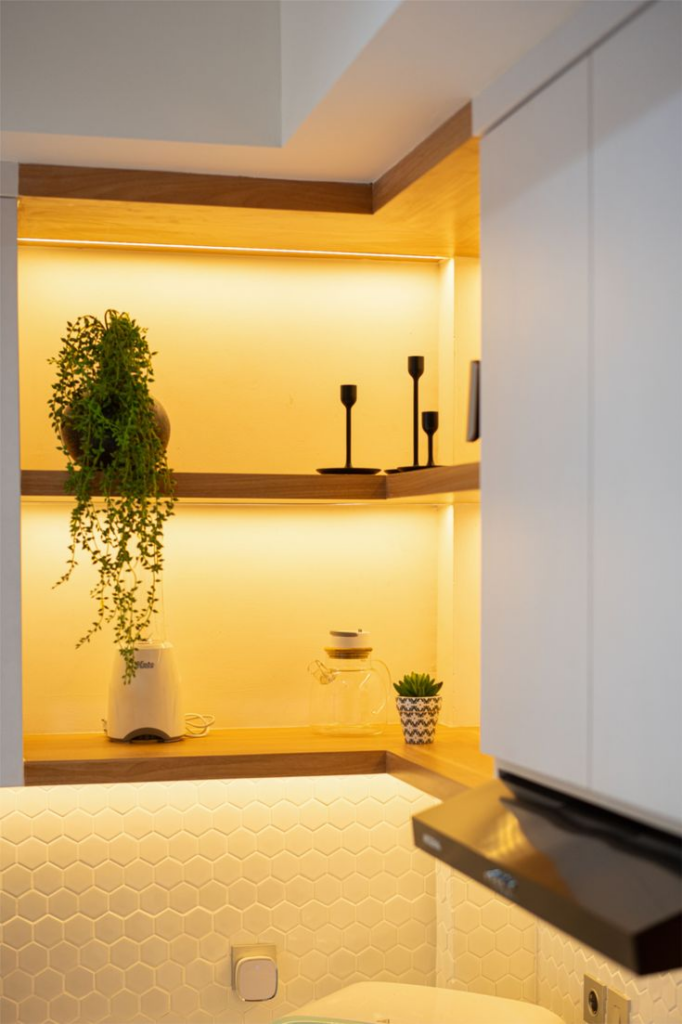
Installing wall-mounted floating shelves with integrated lighting presents a sleek, contemporary approach to home libraries. These open shelves offer flexibility in height and layout, letting homeowners customize the space to suit both aesthetic preferences and book sizes. LED strip lighting beneath each shelf subtly highlights the spines, enhancing readability and ambiance without being harsh. Ideal for minimalist interiors or tight wall spaces, this configuration avoids bulk while still offering generous storage. Opt for matte black brackets or concealed mounts for a clean, uninterrupted line. The floating look keeps the floor area open, making rooms feel airier and less cluttered. Combining books with occasional décor pieces—like framed art or planters—ensures visual interest without overwhelming the design. Perfect for bedrooms, hallway alcoves, or office corners, this idea works especially well in homes where subtlety and sophistication go hand in hand. The blend of light, air, and literary charm is timeless.
Modular Shelving Units
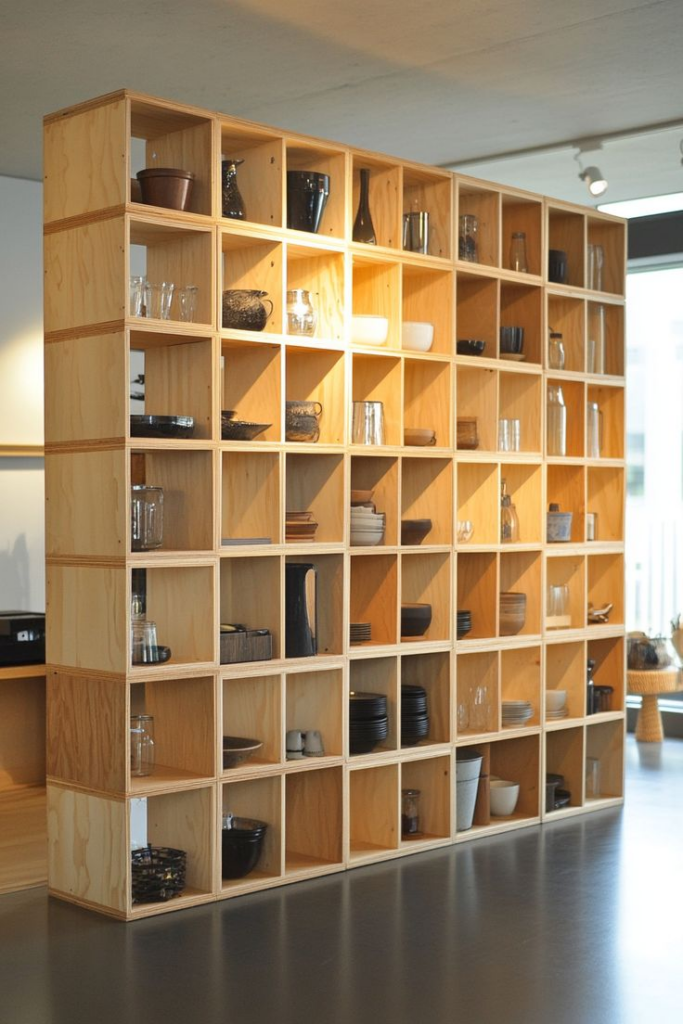
Flexible shelving systems allow home libraries to evolve as collections grow or tastes shift. Modular units, often made from metal frames and wood inserts, can be reconfigured to fit new layouts or expand vertically and horizontally. This adaptability is particularly useful for renters or those who move often, as units can be disassembled and reassembled with ease. Some designs include closed storage or adjustable dividers, enabling a mix of books, files, and display items. Open-back models are ideal for placing against feature walls or using as room dividers. Available in a wide range of finishes—from walnut veneer to high-gloss white—modular systems suit modern and transitional spaces alike. For larger rooms, grouping several units together creates a dramatic floor-to-ceiling effect, while smaller setups work well in nooks or beside desks. This approach delivers a tailored, scalable library that aligns with changing needs, blending storage, accessibility, and smart style.
Circular Bookcase Design

For homeowners seeking a standout centerpiece, a circular bookcase provides both form and function. These unique designs can be freestanding or built into curved alcoves, offering 360-degree storage and a sculptural presence. Often crafted from wood, metal, or MDF with laminated finishes, the shelves follow a radial layout that supports both standard-sized and decorative books. Center columns may house additional storage or seating, depending on the model. Ideal for open-plan areas, these bookcases serve as natural dividers between living zones or act as a dramatic anchor in reading rooms. Overhead lighting enhances the architectural curves, while low-slung versions can double as coffee tables in large lounges. The circular format promotes browsing from all sides and encourages creative display arrangements. Whether placed in a corner, foyer, or central room, this statement piece introduces artistic flair while remaining deeply practical. It’s a fresh alternative to traditional linear libraries.
Library with Integrated Plant Displays

Pairing greenery with book storage creates an immersive, biophilic reading space that encourages tranquility and wellness. Shelving units designed with dedicated plant pockets or trailing spaces accommodate everything from succulents to hanging vines. Built-in planters at varying heights prevent crowding and allow natural light to nourish the foliage. The contrast between earthy greens and spines of aged books adds layered texture and life to any room. Moisture-resistant materials—such as sealed wood or powder-coated metals—extend the longevity of both plants and furniture. Integrating grow lights beneath shelves ensures health for low-light plants, even in windowless spaces. This hybrid layout works beautifully in sunrooms, bedrooms, or contemporary living areas. In addition to improving air quality, it enhances visual balance and encourages longer stays within the reading zone. The result is not only a functional library but a rejuvenating oasis where nature and literature coexist in perfect harmony.
Convertible Furniture with Hidden Storage

Optimizing small spaces demands multifunctional solutions, and furniture that blends reading comfort with concealed storage delivers efficiency without aesthetic compromise. Ottoman-style benches with lift-top lids, armchairs with side cubbies, or coffee tables with hidden compartments all contribute to an uncluttered reading environment. In smaller home libraries, these dual-purpose pieces preserve floor space while ensuring everything from books to throws stays organized and out of sight. Fold-out desks that tuck into shelves or Murphy beds paired with overhead bookcases add even more utility. Soft-close mechanisms and smooth hinges enhance ease of use, while upholstery in neutral or textured fabrics maintains design integrity. This solution is particularly well-suited for apartments or multipurpose rooms where space is at a premium. The flexibility of convertible furniture allows the library to adapt to evolving needs without sacrificing style or comfort. It’s an intelligent blend of design ingenuity and lifestyle practicality.
Color-Coded Book Arrangement

Organizing books by color isn’t just a design trend—it’s a strategic method that transforms ordinary shelves into vibrant displays. By sorting spines into coordinated hues, homeowners achieve a visually unified look that doubles as a focal point. Whether you follow the ROYGBIV spectrum or group neutrals for a monochrome palette, the result adds both order and personality. For those with large, varied collections, subtle dividers or labeled tabs can aid in locating specific titles without disrupting the flow. This technique works best with open shelving or glass-front cabinets, where color visibility is maximized. Balancing bright colors with neutral bookends or accessories prevents visual overwhelm. Ideal for design-forward individuals, color-coded arrangements also complement minimalist or Scandinavian-style libraries. It’s a simple yet striking way to infuse your space with creativity and polish. More than just aesthetics, this method encourages regular curation and brings a fresh rhythm to your reading experience.
